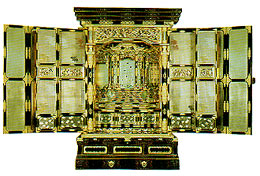HOME >>
Mikawa Butsudan (Buddhist family altar)
Keeping history and cultural values alive
 |
It is recorded that in 1235, Shinran, a holy priest, preached Buddhism at Myogenji temple in Yahagi Town, Okazaki City, and in 1256, another holy priest Kenchi preached at Yakushiji temple in Kuwako in the same town. People's faith in Buddhism in the Mikawa district has a very long history. With the benefits of the protective policy by the Tokugawa Family, Mikawa Butsudan enjoyed great prosperity. These days, however, younger people are attracted by modern industries such as the auto industry and children of the craftsmen tend to leave their family occupation. The shortage of successors in the Butsudan industry is serious. In order to hand down the long and distinguished history of Mikawa Butsudan and its value as cultural assets over to future generations, Mikawa Butsudan Promotion Cooperative and other industrial sectors are carrying out various kinds of promotional activity. |
- Materials traditionally used
-
- Wood: Japanese cypress, zelkova, himekomatsu, magnolia hypoleuca, yew, sennoki, or other timbers of similar quality
- Metal fittings: copper, copper alloy, or other materials of similar quality
- Lacquer: natural lacquer
- Manufacturing districts
- Cities of Toyohashi, Okazaki, Handa, Toyokawa, Hekinan, Kariya, Toyota, Anjo, Nishio, Gamagori, Tokoname, Shinsiro, Tokai, Obu, Chiryu, Takahama, and Toyoake
- Towns of Higashiura and Taketoyo in Chita County,
- Town of Isshiki in Hazu County, Koda Town in Nukata County, Miyoshi Town in Nishikamo County,
- Asuke Town and Shimoyama Village in Higashikamo County,
- Mito Town in Hoi County, and Tawara Town in Atsumi County
- Date when designated as a traditional craft
- December 15, 1976
- Numbers of business establishments and workers
- 133 establishments and 515 workers
Arimatsu Narumi Shibori / Tokonameyaki / Nagoya Butsudan
Mikawa Butsudan / Toyohashi Writing Brushes / Akazuyaki
Okazaki Stonemasonary / Nagoya Kiritansu / Nagoya Yuzen
Nagoya Kuromontsuki-zome / Owarishippo / Seto Sometsukeyaki
